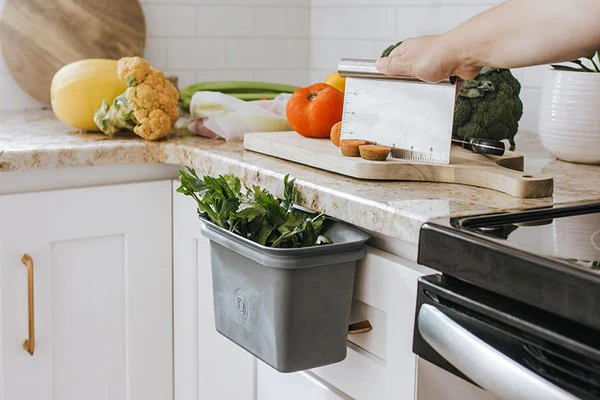Sustainability is more important than ever, and the kitchen is a great place to start implementing eco-friendly habits. By adopting sustainable cooking practices, you can reduce waste, conserve energy, and contribute to a healthier planet. This guide will walk you through practical and effective ways to reduce waste while cooking, helping you create a more sustainable kitchen environment.
-
Plan Your Meals to Minimize Waste
Meal planning is one of the easiest and most effective ways to reduce kitchen waste. By planning your meals ahead of time, you can ensure that you only buy what you need, reducing the likelihood of food going to waste.
How to Plan Your Meals:
- Create a Shopping List: Write down exactly what you need for the week and stick to it. Avoid impulse purchases that could lead to unused or expired ingredients.
- Use What You Have: Check your pantry, fridge, and freezer before shopping to avoid buying duplicate items. Incorporate these ingredients into your meal plan.
- Batch Cooking: Prepare meals in bulk and store them for later use. This not only saves time but also helps reduce waste from single-use packaging and leftover ingredients.
-
Store Food Properly to Extend Its Life
Proper storage is essential for preserving food and preventing it from spoiling prematurely. Using the right storage techniques can significantly reduce food waste in your kitchen.
Tips for Proper Food Storage:
- Invest in Airtight Containers: Store dry goods like rice, pasta, and flour in airtight containers to keep them fresh longer.
- Use the Freezer Wisely: Freeze leftovers or extra portions of meals to extend their shelf life. Freezing fruits, vegetables, and bread can prevent them from going bad too quickly.
- Label and Date Items: Label containers with the contents and the date they were prepared or purchased. This helps you keep track of what’s inside and when it needs to be used.
-
Compost Food Scraps

Not all food waste can be avoided, but you can still make a difference by composting. Composting food scraps like fruit peels, vegetable trimmings, and coffee grounds helps reduce the amount of waste that ends up in landfills, while creating nutrient-rich soil for gardening.
How to Start Composting:
- Set Up a Compost Bin: You can compost at home using a small indoor compost bin or an outdoor compost heap. Look for bins that suit your space and needs.
- Compostable Items: Most fruit and vegetable scraps, eggshells, coffee grounds, and tea bags can be composted. Avoid composting meat, dairy, and oily foods, as these can attract pests.
- Use Compost in Your Garden: Once the food scraps have broken down, use the compost in your garden or potted plants to enrich the soil.
-
Reduce Single-Use Packaging
Single-use plastics and packaging contribute significantly to kitchen waste. By making conscious choices to reduce reliance on disposable packaging, you can make your kitchen more sustainable.
Strategies to Reduce Packaging Waste:
- Buy in Bulk: Purchase dry goods, spices, and other essentials in bulk to minimize packaging waste. Bring reusable containers or bags when shopping at bulk stores.
- Choose Reusable Alternatives: Replace plastic wrap with reusable food wraps, such as beeswax wraps. Use glass or stainless steel containers instead of single-use plastic bags.
- Avoid Individually Packaged Items: Opt for larger containers of yogurt, snacks, and other foods rather than single-serving packages. This reduces the amount of plastic or paper waste you generate.
-
Cook with Less Energy
Energy consumption in the kitchen can be reduced with a few simple adjustments to your cooking methods. Conserving energy not only helps the environment but also lowers your utility bills.
Energy-Saving Cooking Tips:
- Use the Right Size Burner: Match the size of your pot or pan to the burner. Using a small pot on a large burner wastes energy.
- Cover Pots While Cooking: Covering pots while cooking reduces cooking time and conserves energy by trapping heat.
- Opt for Energy-Efficient Appliances: Use energy-efficient kitchen appliances, such as induction cooktops, slow cookers, and pressure cookers, which use less electricity than traditional stovetops and ovens.
-
Get Creative with Leftovers
Reducing food waste doesn’t stop after the meal is cooked. Finding creative ways to use leftovers can help you get the most out of the ingredients you buy and prevent perfectly good food from going to waste.
Ideas for Using Leftovers:
- Repurpose Leftovers: Turn last night’s dinner into today’s lunch by adding new ingredients or transforming it into a different dish. For example, roast chicken can be used for salads, sandwiches, or soups.
- Freeze Leftovers: If you know you won’t eat leftovers right away, freeze them for future meals. This keeps them fresh and ready when you need a quick meal.
- Make Stock or Broth: Save vegetable scraps, meat bones, and herbs to make homemade stock or broth. This is an excellent way to repurpose items that would otherwise be thrown out.

